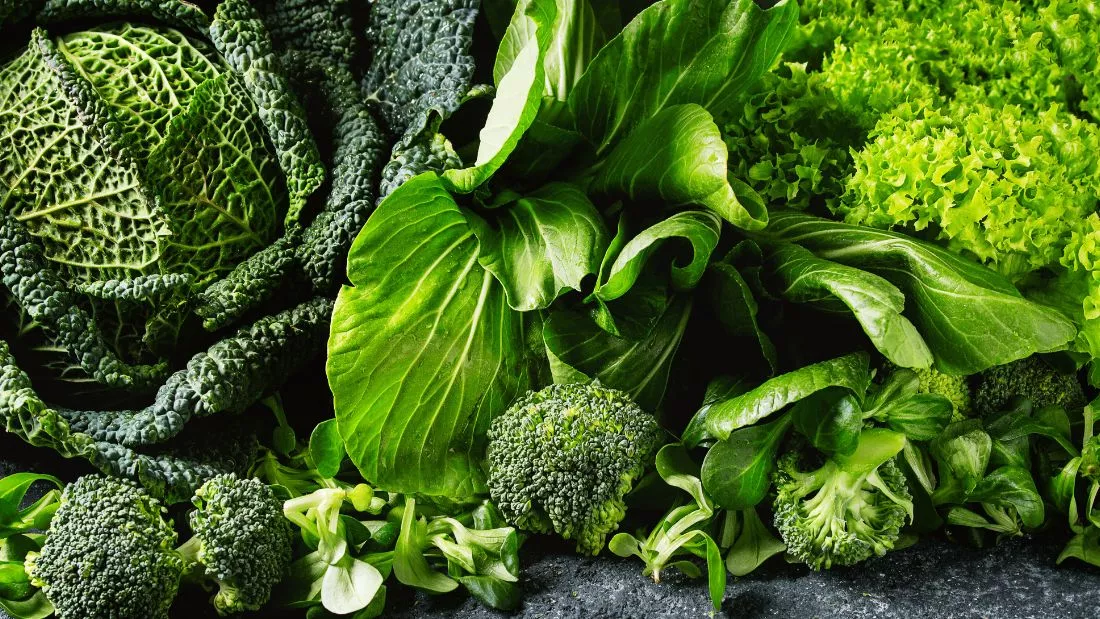Eat your greens!

Why and how to incorporate more greens into your diet
We know that vegetables are good for us but why? Is there anything more to them than just vitamins? Yes, there is and it might surprise you just how many health-protective nutrients they contain – especially the green kind!
And if you’re not a big fan of greens, don’t worry – there are many ways you can trick yourself into getting your daily dose without eating a pile of veggies on their own.
What are green vegetables?
Technically, any vegetable that is…well, green should count but the term ‘green vegetables’ or ‘greens’ is a short for ‘leafy green vegetables.’ It usually includes kale, broccoli, rocket, cabbage, Brussels sprouts, watercress, spinach, chard etc. and by definition, we eat only the leaves and flowers (in the case of broccoli) of these veggies.
Not included in the list are cucumbers, courgettes, celery or avocado. They may be green but they have very different nutritional qualities.
How about lettuce?
Most types of lettuce are green but are not very nutrient-rich compared with other leafy greens so you really need to combine them with other greens for maximum health benefits.
Why are they good for us?
Most leafy greens belong in the cruciferous family, which includes bok choy, broccoli, Brussels sprouts, cabbage, cauliflower, Collard/spring greens, kale, rocket and watercress. All cruciferous vegetables contain very powerful natural compounds that have a strong cancer-fighting effect. These compounds are called glucosinolates and their breakdown products, such as isothiocyanates, are believed to be responsible for their health benefits.
Making the most of them requires an inbuilt enzyme that makes the production of the effective compounds possible but it can get destroyed by heat. Hence, it’s best to eat the greens raw or briefly steamed. There is, however, a way around the problem – just add a pinch of mustard powder during cooking as it contains the necessary enzyme that will do the job.
Cruciferous vegetables are also packed with antioxidants, which help to maintain general good health, protect your organs and strengthen your immune system. On top of this, they are a good source of essential nutrients such as folic acid (folate), vitamins C, E and K and fibre. And that’s not all! These greens pack a good dose of minerals such as calcium, potassium and iron, which your body easily absorbs – for example, you absorb more calcium from kale than from milk! And they also contain valuable protein and healthy omega-3 fats.
Chard and spinach are a little different
These two leafy greens are good sources of vitamins A (as beta-carotene), C, E and K, folate, calcium, magnesium, manganese, iron and potassium. Both are also rich in antioxidants that give them cancer-fighting properties and protect eye-health.
Where they’re different from other green leafy vegetables is in their oxalate content. Oxalates are natural compounds that may increase the risk of kidney stones in people prone to the condition and may also lower the absorption of essential minerals such as calcium. The good news is that cooking reduces oxalate levels in both spinach and chard by up to 85 per cent. Baby spinach and chard leaves are popular salad ingredients but it’s best to consume these two veggies cooked.
If you’re prone to kidney stones or have kidney disease, your doctor may recommend you follow a low-oxalate diet. In that case, swap spinach and chard for other leafy greens, such as kale or bok choy.
What else can greens do?
A large study found that regular consumption of leafy green vegetables – cruciferous and also spinach and chard – was linked to slower cognitive decline in older adults. The rate of decline among those eating one to two servings a day was the equivalent of being 11 years younger compared with those who rarely or never consumed these greens!
Six ways to eat more greens
Now you know how amazing leafy greens are, you probably want to make them a part of your daily menu. If you’re a fan, you probably already enjoy eating them on their own or in simple combinations – but how to trick your own taste buds if you’re not a fan?
- Smoothies – not the obvious choice but a great one nevertheless! You can ‘hide’ all sorts of leafy green vegetables in a smoothie, especially in a combination with banana and orange or pineapple.
- Soups – just like with smoothies, if you blend the soup, you might hardly notice the veggies are there, particularly if you add the right spices!
- Pasta sauces – finely chop your veggies and add in a tomato sauce or blend them with cashews into a creamy sauce. And why not try making a green pesto with greens and plenty of basil?
- Curries or stews – the principle is the same as above – blend some greens into the sauce or add finely chopped pieces. The strong flavours of curry are especially good at helping you to forget you’re also eating healthy greens!
- Sandwiches and wraps – this one needs a little more invention and effort. You can make your own sandwich fillings, such as tofu ‘egg’ salad or chickpea ‘tuna’ salad, and add finely chopped rocket, watercress or alfalfa. Or, why not add a handful of rocket or shredded cabbage to a falafel or tofu wrap?
- Fry or sauté your greens with garlic and soya sauce – this combination is an easy winner for almost everyone. Adding minced ginger makes it even better and it works with broccoli, kale, cabbage, Brussels sprouts, spring greens, bok choy, chard and savoy cabbage too.
Should I eat greens every day?
Yes! In, fact, it’s recommended to eat at least one portion (roughly a handful) of greens daily to support your health. And don’t forget that green leafy veggies are also valuable sources of calcium and iron and that’s nothing to scoff at!



